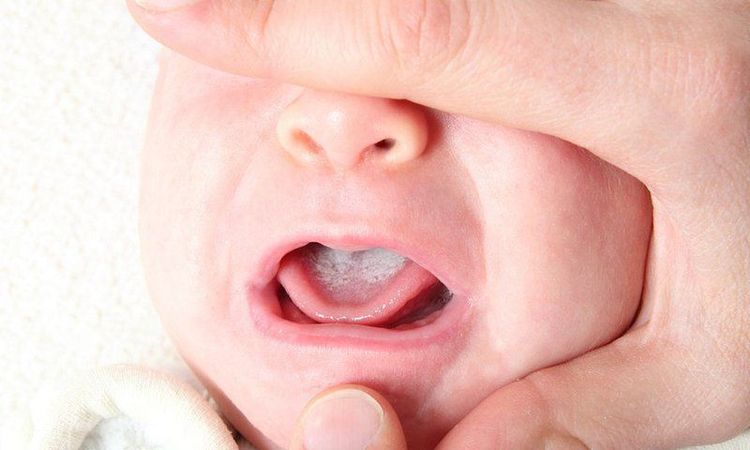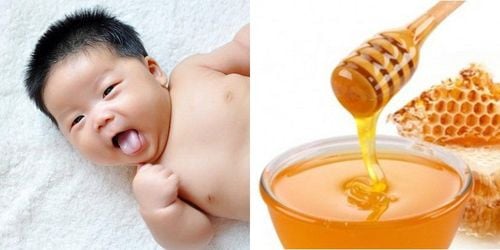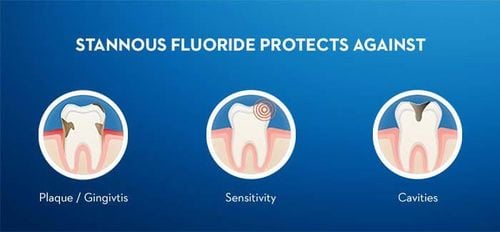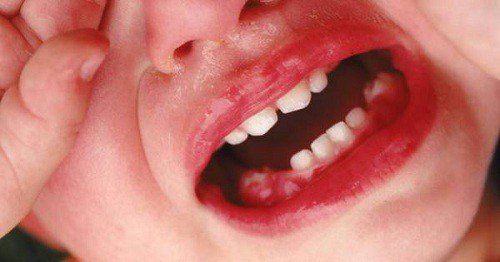This is an automatically translated article.
White patches in the mouth are a sign of thrush in babies. The disease usually occurs due to excessive yeast content mainly in the mouth and oropharynx.
1. What is the disease in children with white patches in the mouth?
White patches in the mouth are a sign of thrush . Thrush causes creamy white or yellow patches to develop on the sides, roof, gums, lips, and tongue of a child. It can also spread to the throat, tonsils, or esophagus. Thrush is most common in infants and toddlers.
2. What causes thrush in babies?
Thrush occurs when the body has an imbalance of yeast. Antibiotics are one of the causes of thrush in children because along with killing pathogens, it also kills a large number of “good” bacteria (which control yeast in the body). .
Some mothers and babies pass the infection back and forth. Babies can transmit thrush to their mothers during breastfeeding and vice versa. However, there are also cases where mother and child do not transmit the disease to each other when one of them is sick.
Thrush can also occur when babies hold bottles or pacifiers for a long time, unhygienic. However, babies who are exclusively breastfed and do not use a pacifier can still develop thrush, so it is difficult to determine the cause. Some babies and mothers are simply more susceptible to yeast infections than other babies and mothers.

Tưa lưỡi xảy đến khi cơ thể mất cân bằng nấm men
3. What are the symptoms of thrush?
If you notice a white coating on your tongue, it's probably just milk residue. Test it by wiping your child's tongue. If it's not milk residue, see your doctor if you see any of the following:
White or yellow patches on your baby's lips, tongue, roof of the mouth, or the inside of your baby's cheeks, gums or throat. Thrush patches look like small pieces of cheese that don't wash off easily. Babies cry when being fed or sucked on a pacifier or bottle. That's because the white or yellow patches can be painful and make sucking uncomfortable if the infection is severe. Note: Some babies with thrush feel no pain or discomfort during breastfeeding. Some children with thrush also develop a yeast rash. A raised, widespread, or bright red or dark rash with a clear border. Small red bumps, which can be tender or painful, often appear around the rash. The rash can creep into the folds of skin around the genitals and legs, and rarely appears on a child's bottom.
4. How to treat thrush?
If a child is diagnosed with thrush, the medications commonly prescribed are an oral antifungal (usually nystatin) and the pain reliever acetaminophen . The infection usually goes away after about two weeks of treatment.
For cases of diaper rash, nystatin ointment can be applied to the diaper area.
If you are breastfeeding a baby with thrush, applying nystatin or clotrimazole to your nipples can help reduce transmission between mother and baby.
You should see your doctor again if the infection does not clear up after treatment. Recurrent thrush is quite common in children.

Nếu trẻ được chẩn đoán tưa lưỡi có thể dùng thuốc kháng nấm
5. How to prevent thrush in children?
Some of the following measures can help reduce the risk of thrush in children. It also works for both mother and baby being treated for thrush.
Do not give your baby antibiotics unless absolutely necessary because antibiotics do not help against viral infections. In fact, thrush often starts with antibiotics. Clean and sterilize a pacifier after each use, and disinfect any toys that come into your baby's mouth. Allow nipples to air dry between feeds. If you are bottle-feeding, thoroughly clean all equipment, including the nipples, after each use by rinsing with hot, soapy water or in the dishwasher. Wash your hands often, especially after feeding and changing diapers. Change diapers often to prevent yeast from causing diaper rash.
6. Is thrush dangerous?
Thrush is not dangerous for young children. However, it makes babies fussy and painful to suckle, hindering breastfeeding performance.
Families need to take necessary comfort actions for the child and follow the doctor's medication instructions.

Tưa lưỡi khiến trẻ quấy khóc và đau đớn khi bú
7. How to treat thrush at home? Can gentian violet be used to treat thrush in children?
Gentian potassium permanganate should only be used under the direction of a doctor. This is an effective antifungal drug. However, if the medicine is used for too long or in too high a concentration, it can cause sores in the child's mouth.
Gentian potassium permanganate can be prepared by:
Buy a 1% solution of gentian potassium permanganate. You can find it in many pharmacies or order it at a drugstore. To prevent side effects such as mouth sores, dilute this solution to make potassium permanganate 0.25% or less by mixing one part gentian potassium permanganate solution with two parts water. Before applying gentian potassium permanganate, remove your baby's clothes from the waist up so as not to stain the baby's clothes. Then put a towel down to protect the surface underneath. Use gentian potassium permanganate according to the following steps:
First, apply a thin layer of mineral fat to the baby's lips and cheeks to avoid smearing. Use a cotton swab to apply the diluted solution to the inside of your baby's mouth. Have someone help you hold your baby's head and hands while you poke the inside of your baby's lips, cheeks, and tongue. Apply the drug once a day for no more than seven days. The dye is safe and won't harm the nipple when it gets on during breastfeeding. Although thrush is not too dangerous to the health of children, if not treated promptly, it can lead to more serious conditions. Parents should consult a doctor for the best treatment for thrush in children.
When a child shows abnormal signs of health, parents can take the child to Vinmec Health system for timely examination and treatment.
As a key area of Vinmec Health System, Pediatrics Department - Vinmec International General Hospital always brings satisfaction to customers and is highly appreciated by industry experts thanks to the following advantages:
gathers a team of leading doctors and doctors in Pediatrics: including leading experts, with high professional qualifications (professors, associate professors, doctorates, masters), experienced, having worked in different hospitals. big hospitals like Bach Mai, 108.. The doctors are all well-trained, professional, have a heart - reach, understand young psychology. In addition to domestic pediatric specialists, the Department of Pediatrics also has the participation of foreign experts (Japan, Singapore, Australia, USA) who are always pioneers in applying the latest and most effective treatment regimens. . Comprehensive services: In the field of Pediatrics, Vinmec provides a series of continuous medical examination and treatment services from Newborn to Pediatric and Vaccine,... according to international standards to help parents take care of their baby's health from birth to childhood. from birth to adulthood Specialized techniques: Vinmec has successfully deployed many specialized techniques to make the treatment of difficult diseases in Pediatrics more effective: neurosurgery - skull surgery, stem cell transplantation. blood in cancer treatment. Professional care: In addition to understanding children's psychology, Vinmec also pays special attention to the children's play space, helping them to have fun and get used to the hospital's environment, cooperate in treatment, improve the efficiency of medical treatment.
Please dial HOTLINE for more information or register for an appointment HERE. Download MyVinmec app to make appointments faster and to manage your bookings easily.
Reference source: babycenter.com












